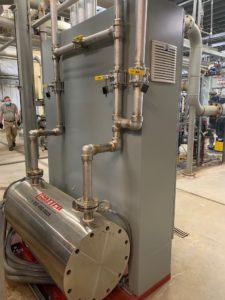Types of Steam in Process Heating Applications
Last updated on May 8th, 2025 at 05:24 am
The thermal energy transfer capabilities of steam make it an ideal solution for all sorts of process heating applications. We use them in everything from sanitization in the labs that created the COIVD vaccines to power generation in the plants that provide energy to homes and businesses.
While steam is widely applicable, you can’t just use any steam for any application. Each process heater has different kinds of steam best suited to its purpose. This article discusses some of the most common types of steam in process heating applications.
Saturated vs. Superheated Steam
Simply put, there are two basic types of steam; saturated and superheated. In addition to these two, there are multiple subcategories of steam for various applications.
Saturated Steam
Saturated steam, or dry steam, is the most common type for industrial use. This type of steam has excellent heat transfer capabilities, making it a great solution for most process heating projects.
In addition to its heat transfer coefficient, saturated steam is quick to create and offers a great degree of control. It supplies even heating and temperature is accurately managed by controlling pressure.
This type of steam is created by boiling water with a boiler heater. The heat is increased until it vaporizes the steam. This method removes the moisture from the vapor, hence why it is also known as dry steam. The process is simple and cost-effective, further contributing to saturated steam’s widespread use.
Superheated Steam
Superheated steam is used less for heating applications and more for steam generation to power turbines. This steam has a lower heat transfer coefficient, so it is more limited in its uses.
The benefits of superheated steam, however, make it ideal for applications like steam turbines. Unlike saturated steam, it has a constant pressure regardless of temperature. It also offers lower density and can provide higher temperatures in contrast to saturated steam.
While saturated steam is dry, is superheated is even more so. This dryness is another advantage it has for use in turbines. Steam in turbines may cool during the process. Any moisture in the steam can then turn to condensation. As waterdrops form they fly at high velocity, causing potential damage. It can also lead to erosion of turbine blades and excess emissions.
Electric heaters superheat the steam to prevent condensation in turbines, making it extra dry.
This type of steam begins as saturated steam. High power process heaters are then used to heat the steam even further. In this way, it can avoid increasing pressure while creating high-temperature steam.
Culinary Steam
As the name implies, culinary steam is common in the food and beverage industry. Because it creates products for human consumption, this type of steam is carefully regulated. It needs to be free of contaminants and corrosion. The heater uses stainless steel materials, and the steam must pass through a filtration system. As well, they typically use corrosion inhibitors.
Although the FDA regulates the quality of culinary steam, it is still separate from pure and clean steam. As well, culinary steam generation is less expensive than pure steam.
Filtered Steam
As with culinary steam, filtered steam must pass through a filtration system. This includes a filter and strainer that removes condensation as well as all sorts of contaminants and impurities that can enter the system.
This type of steam is primarily used for sterilization. The strictness of regulations and the items to be sterilized determine whether filtered, clean, or pure steam is required.
Pure Steam
 High-quality electric feedwater and boiler heaters are used to generate cleaner steam. Pure steam has the highest purity grade for steam and is used for the most sensitive and sterile conditions. For instance, all injectables require pure steam for sterilization in the pharmaceutical industry.
High-quality electric feedwater and boiler heaters are used to generate cleaner steam. Pure steam has the highest purity grade for steam and is used for the most sensitive and sterile conditions. For instance, all injectables require pure steam for sterilization in the pharmaceutical industry.
Pure steam generation requires careful material selection. The feedwater must be double osmosed, and the boiler should be stainless steel to prevent impurities. Pure steam is only used where necessary because of its higher production cost.
Clean Steam
Clean steam is similar to pure steam but requires a slightly lower purity grade. Feedwater can use demineralized or osmosed water, although a stainless steel boiler is still required.
Cheaper than pure steam, it is an economical solution where a lesser degree of purity is required. It is still used for sterilization in pharmaceuticals and biotech — but only for non-injectables and processes that don’t require strict endotoxin regulation.
Utility Steam
Utility steam comes from a conventional boiler. It’s cheaper to generate and accounts for most of the saturated steam we use. Also known as plant steam, it can be used to create other types of steam. For instance, filtered steam often starts as utility steam that is then run through a filter and strainer.
Different types of water are used to generate plant steam depending on its end-use. Still, utility steam is not used in pharmaceutical or medical settings.
Flash Steam
Flash steam is utility steam produced through a specific method. It uses high pressure and high temperatures to rapidly generate/discharge steam. Hence the name flash steam. Although its creation method is different, its use and quality are the same as utility steam.
Also read: Diagnosing Heating Systems With Ohmmeters
Electric Process and Boiler Heaters
Wattco custom manufactures electric process and boiler heaters to generate and employ all types of industrial steam. We custom manufacture high-quality products tailored to your specific project needs and budget.
Contact Wattco today for electric heater quotes and information.
